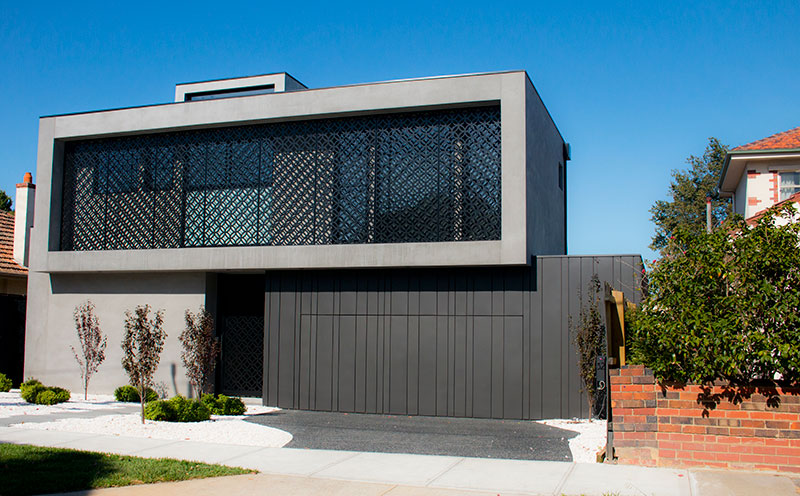The garage door is a popular application for metal cladding. At Metal Cladding Systems we see both feature applications and seamless continuations of wall treatments onto garage doors. Anyone looking to nominate sheet metal on their garage design must consider weight limitations, system and material selection, substrate requirements, durability, lay direction and panel distribution across the door.
It’s one thing to see an image of a complete garage door, and another to go on the specification journey.
To assist in getting from A to B on your garage cladding journey, we have collated our most frequently asked questions and answered them right here, in one spot.
Which Metal Cladding Systems profiles can I specify for garage door applications?
Options are great, but the luxury of choice can complicate things. In theory, any cladding profile can be nominated for garage applications. However material weight and substrate requirements, make some systems more suitable.
Interlocking is a common garage door specification. The Interlocking cladding panel offers a tidy, contemporary wall solution with worry-free suitability.
Key points to consider:
- Standing Seam – Standing Seam must be installed onto a continuous substrate. This should be considered when calculating garage door weight and reviewing the maximum load of the supporting garage frame and motorised components. Standing Seam installations often require superior technical ability and must use dedicated fixing clips and a seam closing tool to successfully complete the installation.
- Interlocking – This profile is well suited to garage door cladding. Panels can be installed onto metal battens or a continuous substrate. Interlocking is an approachable, flexible panel with a straightforward installation method.
- Nailstrip – Similar to Interlocking, Nailstrip can be successfully installed onto metal battens or a continuous substrate. Nailstrip also has a simple installation method, making it a lightweight alternative to Standing Seam.
- Snaplock – Snaplock is a straightforward system to install, but it’s best practice to install Snaplock onto a continuous substrate – making it a less popular option for garage door cladding. The additional continuous layer can, in some cases, tip the system weight over some garage door manufacture’s weight restrictions.
- Shingle and Flatlock – Shingle and Flatlock are statement making profiles. Both systems require a continuous substrate, however their eyecatcing appearance makes them a go-to for feature cladding zones. If you’re considering Shingle or Flatlock, speak with the Metal Cladding Systems technical team and your garage door supplier prior to finalising your specification. Shingles in particular may become heavy, because each panel is a small tile, and each tile has four material folds.
- This advice is a suggestion only. Many garage door frames can support continuous substrates and metal panels.
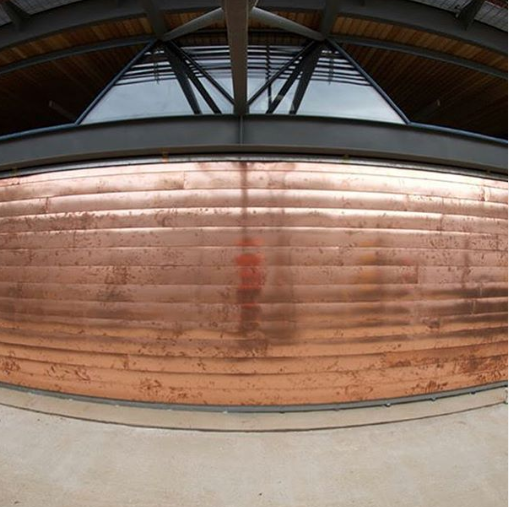
Installation and photo: Specialized Roofing and Cladding
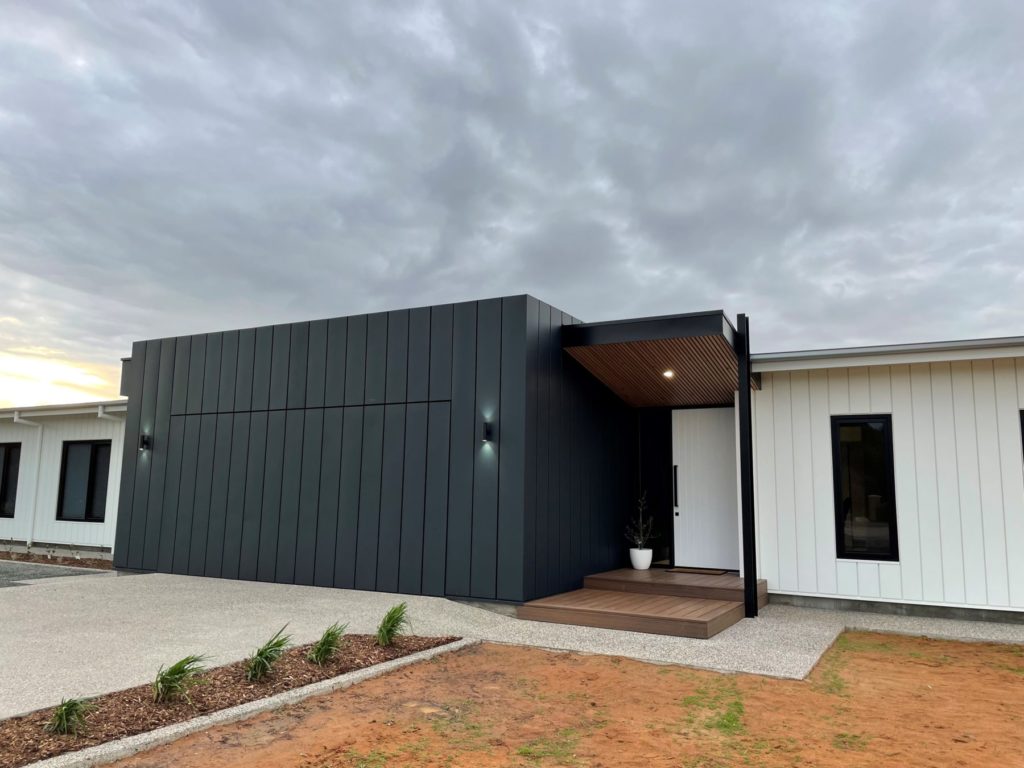
Installation and photo: McNight & Bray
Are some metals better suited to garage doors?
All metals in our Metal Cladding Systems material offering are suitable for garage door applications. Weight, project location, and atmospheric conditions should be considered and used as determining factors in deciding which alloy is best for your project.
At only 2.25kg per sqm (flat sheet), aluminium is close to half the weight of steel, titanium zinc and natural copper; making it ideal for garage door specification. Pre-painted aluminium offers an extensive range of textures, patterns, and colours.
Garage door cladding can be more prone to oil-canning compared to fixed wall panels. Movement in the operable door can increase the likelihood of visible pillowing. Oil-canning is rarely a product or installation flaw (read more on oil-canning here) and some materials are less likely to present visible oil-canning. Light colours are less likely than dark colours to oil-can, and textured products such as Colorbond Steel Matt and Vestis Nebula aluminium are less reflective and therefore less likely to oil-can.
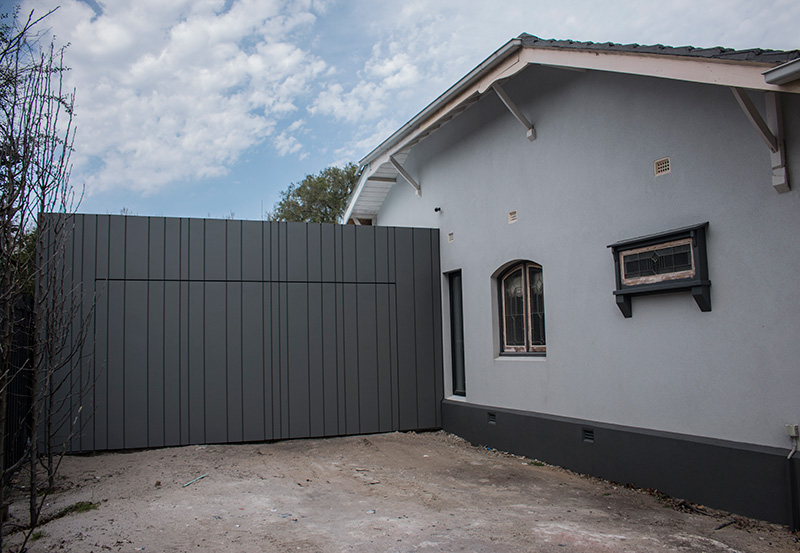
Installation by: Artisan Facades
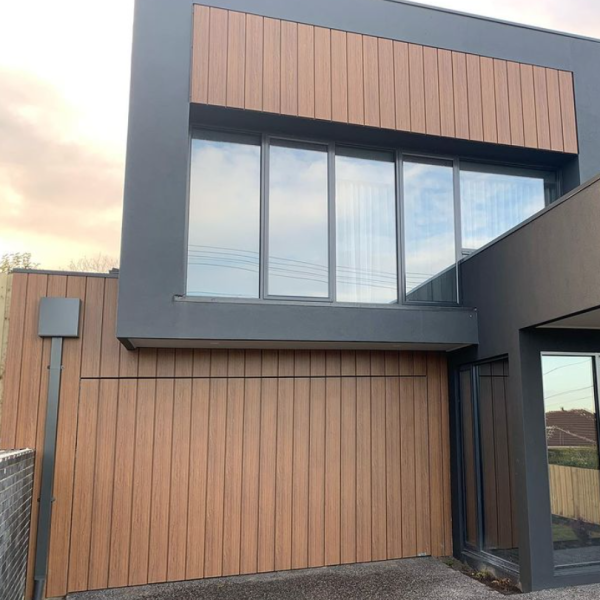
How many panels will I need to clad my door?
When working on a supply and install program, a Metal Cladding Systems’ aligned and experienced installer will calculate your project panel requirements. If you are working on a supply only program, panel calculation is the responsibility of the party conducting the installation.
Garage door width, cladding profile and panel cover size are needed to start a project panel quantity calculation. Garage door surrounds and specialised start and finish installation techniques may also impact the number of panels needed. Every project is unique and Metal Cladding Systems always recommend an experienced installer conducts the project-specific site measure. To get in touch with a reputable contractor, speak with our technical service team by clicking here.
Nominating panel quantity is the responsibility of the party conducting the installation. If you are looking to install your own garage door cladding you will need to measure the door span and work out your ideal panel cover width. The Metal Cladding Systems team can assist with identifying cost-effective cover sizes, but the final panel nomination must come from the party conducting the installation.
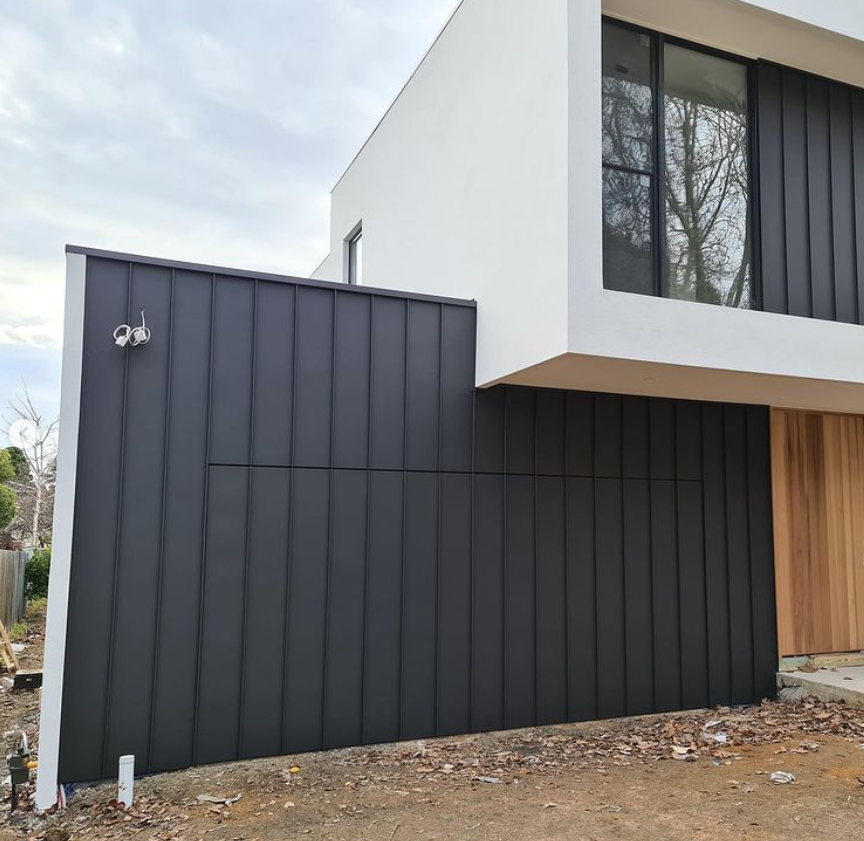
Installation and phot: Advanced Metal Cladding
My garage door company says there is a weight limit for the door. How much will the cladding weigh?
Weight is important in garage door specifications because every garage door manufacturer has weight limits. When calculating the weight of a Metal Cladding Systems panel configuration, you will need the following:
- Cladding profile
- Panel cover width and panel cut size
- Material
- Material weight per square metre or lineal metre
- Width of the material coil
- Garage door size
Some of the information listed above will need to come from the Metal Cladding Systems technical service team; they can also help you calculate your garage door’s weight. If you would like to tackle the calculation yourself (well done you), this section will be your go-to guide.
The table below will work as a quick material weight reference (flat sheet). It also supplies important figures which can be used when calculating your overall garage cladding weight.
| Material | Weight per sqm | Coil width | Weight per l/m |
| Colorbond Steel 0.55 mm | 4.372 kg | 1200 mm | 5.54 kg |
| UniCote LUX 0.55 mm | 4.372 kg | 1200 mm | 5.54 kg |
| Vestis Aluminium 0.80 mm | 2.25 kg | 1200 mm | 2.65 kg |
| Titanium Zinc 0.70 mm | 5.04 kg | 1000 mm | 5.04 kg |
| Titanium Zinc 1 mm | 7.20 kg | 1000 mm | 7.20 kg |
| Natural Copper 0.55 mm | 4.906 kg | 1200 mm | 5.89 kg |
If you’re keen to identify your garage door’s exact folded panel weight, you will need to contact Metal Cladding Systems and let our team know which cladding system you’re working with and your panel width. Please note: we do not calculate random width configuration door weights.
As an example, let’s look at one of our most common garage door specifications, a 205mm cover, Vestis aluminium, Interlocking panel.
Interlocking “cover” = face of panel width + express width.
| Profile | Interlocking |
| Cover width | 205 mm |
| Blank cut size per panel | 300 mm |
| Panels per sqm | 1000 mm / 205 mm = 4.88 |
Now, for the math …
With the information in the table above, we can now calculate the folded panel weight (accounting for visible – the face of the panel, and hidden material in the system’s folds and/or fixing strips).
Calculating folded panel weight:
- Panels per sqm x blank cut size per panel = material quantity per sqm
- Material quantity per sqm x square metre material weight = weight of folded panels per sqm
Example of calculating panel weight:
- 4.88 x 0.300 m = 1.46 sqm of material
- 1.46 sqm x 2.25 kg = 3.29 kg per sqm of folded 205mm cover Vestis Black Graphite Interlocking panels
The kilogram weight per square metre of your folded panels can then be multiplied across the overall square metre size of your garage door. This information can be given to your garage door provider.
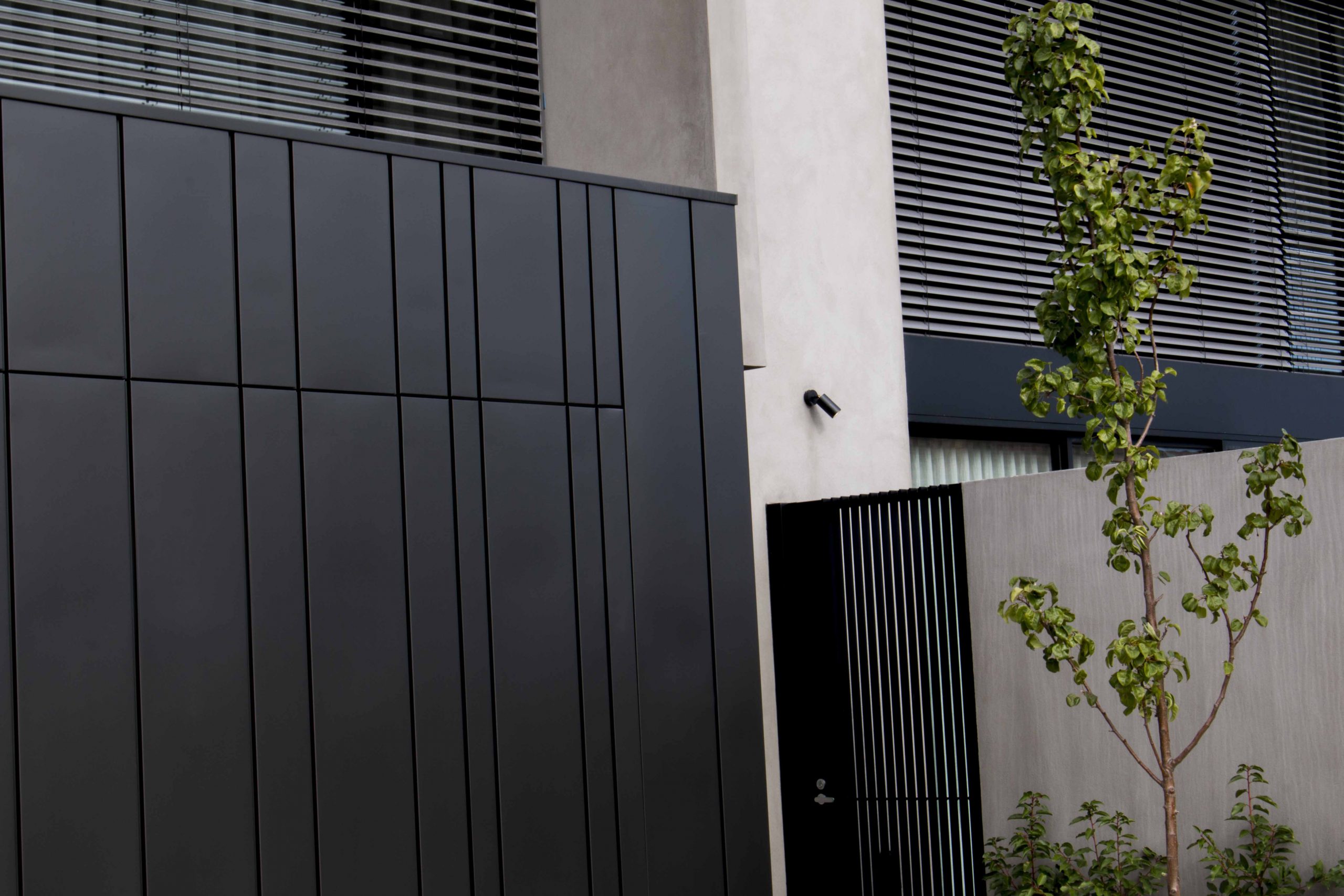
Installation: Advanced Metal Cladding
Want to know more?
Engineers, architects, designers, sheet metal craftsmen and construction professionals make up our service team – and we all love metal cladding. Metal Cladding Systems is open Monday – Friday, 9:00 am – 5:00 pm and our friendly team are happy to discuss your next project via phone or email. Alternatively, you can book an appointment to visit our manufacturing facility and showroom in Braeside, Victoria.


